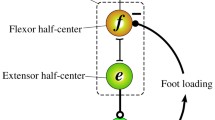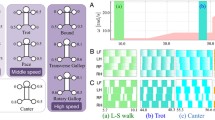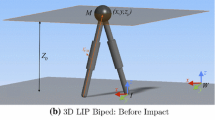Abstract
Golubitsky, Stewart, Buono and Collins proposed two models for the achitecture of central pattern generators (CPGs): one for bipeds (which we call leg) and one for quadrupeds (which we call quad). In this paper we use symmetry techniques to classify the possible spatiotemporal symmetries of periodic solutions that can exist in leg (there are 10 nontrivial types) and we explore the possibility that coordinated arm/leg rhythms can be understood, on the CPG level, by a small breaking of the symmetry in quad, which leads to a third CPG architecture arm. Rhythms produced by leg correspond to the bipedal gaits of walk, run, two-legged hop, two-legged jump, skip, gallop, asymmetric hop, and one-legged hop. We show that breaking the symmetry between fore and hind limbs in quad, which yields the CPG arm, leads to periodic solution types whose associated leg rhythms correspond to seven of the eight leg gaits found in leg; the missing biped gait is the asymmetric hop. However, when arm/leg coordination rhythms are considered, we find the correct rhythms only for the biped gaits of two-legged hop, run, and gallop. In particular, the biped gait walk, along with its arm rhythms, cannot be obtained by a small breaking of symmetry of any quadruped gait supported by quad.
Similar content being viewed by others
References
Alves-Pinto, C.: Coupled oscillators. Phd thesis, Departamento de Matemática Aplicada, Faculdade de Ciências, Universidade do Porto, January (2004)
D’Aout K., Vereecke, E., Schoonaert, K., De Clerq, D., Van Elsacker, L., Aerts, P.: Locomotion in bonobos (Pan paniscus): differences and similarities between bipedal and quadrupedal terrestrial walking, and a comparison with other locomotor modes. J. Anat. 204, 353–361 (2004)
Blickhan R. (1989). The spring-mass model for running and hopping. J. Biomech. 22:1217–1227
Buono P.L. (2001). Models of central pattern generators for quadruped locomotion II. Secondary gaits, J. Math. Biol. 42(4):327–346
Buono P.L., Golubitsky M. (2001). Models of central pattern generators for quadruped locomotion I. Primary gaits. J. Math. Biol. 42:291–326
Bussel B., Roby-Brami A., Neris O.R., Yakovleff A. (1996). Evidence for a spinal stepping generator in man. Electrophysiological study, Acta Neurobiol. Exp. (Wars) 56(1):465–468
Calancie G.E., Needham-Shropshire B., Jacobs P., Willer K., Zych G., Green B.A. (1994). Involuntary stepping after chronic spinal injury. Evidence for a central pattern generator for locomotion in man. Brain 117(5):1143–1159
Caldwell G.E., Whitall J. (1995). An energetic comparison of symmetrical and asymmetrical human gait. J. Motor Behav. 27:139–154
Cohen A.H., Holmes P.J., Rand R.H. (1982). The nature of the coupling between segmental oscillators of the lamprey spinal generator for locomotion: a mathematical model. J. Math. Biol. 13(3):345–369
Cohen A.H., Ermentrout G.B., Kiemel T., Kopell N., Sigvardt K.A., Williams T.L. (1992). Modelling of intersegmental coordination in the lamprey central pattern generator for locomotion. Trends Neurosci 15(11):434–438
Collins J.J., Stewart I. (1993). Coupled nonlinear oscillators and the symmetries of animal gaits, J. Nonlinear Sci. 3:349–392
Collins J.J., Stewart I. (1993). Hexapodal gaits and coupled nonlinear oscillator models. Biol. Cybern. 68:287–298
Collins J.J., Stewart I. (1994). A group-theoretic approach to rings of coupled biological oscillators. Biol. Cybern. 71:95–103
Dietz V. (2002). Do human bipeds use quadrupedal coordination?. Trends Neurosc. 25(9):462–467
Dietz V., Fouad K., Bastiaanse C.M. (2001). Neuronal coordination of arm and leg movements during human locomotion. Eur. J. Neurosc. 14:1906–1914
Dimitijevic M.R., Gerasimenko Y., Pinter M.M. (1998). Evidence for a spinal central pattern generator in humans. Ann. N Y Acad. Sci. 800:360–376
Donker S.F. (2002). Flexibility of human walking: a study on interlimb coordination. PhD Thesis, Sint Maartenskliniek-research, Nijmegen
Donker S.F., Beek P.J., Wagenaar R.C., Mulder T. (2001). Coordination between arm and leg movements during locomotion. J. Motor Behav. 33(1):86–102
Donker S.F., Mulder Th., Nienhuis B., Duysens J. (2002). Adaptations in arm movements for added mass to wrist or ankle during walking. Exp. Brain Res. 145:26–31
Duysens J., Van de Crommert H.W.A.A. (1998). Neural control of locomotion: Part 1: The central pattern generator from cats to humans. Gait Post. 7:131–141
English A.W. (1979). Interlimb coordination during stepping in the cat: an electromyographic analysis. J. Neurophysiol. 42(1):229–243
Farley,C.T., Blickhan, R., Saito, J., Taylor, C.R. Hopping frequency in humans: a test of how springs set stride frequency in bouncing gaits. Am. Physiol. Soc. 2127–2132 (1991).
Frigon A., Collins D.F., Zehr E.P. (2004). Effect of rhythmic arm movement on reflexes in the legs: modulation of soleus h-reflexes and somatosensory conditioning. J. Neurophysiol. 91:1516–1523
Golubitsky M., Stewart I., Buono P.L., Collins J.J. (1998). A modular network for legged locomotion. Physica D 115:56–72
Golubitsky M., Stewart I., Buono P.L., Collins J.J. (1999). Symmetry in locomotor central pattern generators and animal gaits. Nature 401:693–695
Golubitsky, M., Stewart, I.: The symmetry perspective. In: Progress in Mathematics 200, Birkhauser, Basel (2002)
Golubitsky M., Stewart I., Török A. (2005). Patterns of synchrony in coupled cell networks with multiple arrows. SIAM J. Appl. Dynam. Sys. 4(1):78-100
Grillner, S., Buchanan, J.T., Walker, P., Brodin, L.: Neural control of locomotion in lower vertebrates. In: Neural Control of Rhythmic Movements in Vertebrates. Wiley, New York pp. 1–40 (1988)
Harcourt-Smith W.E.H., Aiello L.C. (2004). Fossils, feet and the evolution of human bipedal locomotion. J. Anat. 204:403–416
Hayes G., Alexander R.McN. (1983). The hopping gait of crows (Crovidae) and other bipeds. J. Zool. 200:205–213
Hiebert G.W., Whelan P.J., Prochazka A., Pearson K.G. (1996). Contribution of hind limb flexor muscle afferents to the timing of phase transitions in the cat step cycle. J. Neurophysiol. 75(3):1126–1137
Jenkins F. (1974). Primate Locomotion. Academic, New York
Kopell N., Ermentrout G.B. (1988). Coupled oscillators and the design of central pattern generators. Math. Biosci. 89:14–23
Kopell N., Ermentrout G.B. (1990). Phase transitions and other phenomena in chains of oscillators. SIAM J. Appl. Math. 50:1014–1052
Mann R.A. (1982). Biomechanics. In: Jahss M.H. (eds) Disorders of the Foot. W.B. Saunders and Co., Philadelphia, pp. 37–67
Mann R.A., Moran G.T., Dougherty S.E. (1986). Comparative electromyography of the lower extremity in jogging, running and sprinting. Am. J. Sports Med. 14:501–510
Margaria R., Cavagna G. (1964). Human locomotion in subgravity. Aerosp. Med. 35:1140–1146
Masoud O., Papanikolopoulos N. (2003). A method for human action recognition. Image Vis. Comput. 21(8):729–743
Minetti A.E. (1998). The biomechanics of skipping gaits: a third locomotion paradigm?. Proc. R. Soc. Lond. B. 265:1227–1235
Pearson K.G. (1993). Common principles of motor control in vertebrates and invertebrates. Ann. Rev. Neurosc. 16:265–297
Peck A.J., Turvey M.T. (1997). Coordination dynamics of the bipedal galloping pattern. J. Motor Behav. 29(4):311–325
Preuschoft H. (2004). Mechanisms for the acquisition of habitual bipedality: are there biomechanical reasons for the acquisition of upright bipedal posture?. J. Anat. 204:363–384
Schmidt D. (2003). Insights into the evolution of human bipedalism from experimental studies of humans and other primates. J. Exp. Biol. 206:1437–1448
Verstappen M., Aerts P. (2000). Terrestrial locomotion in the black-billed magpie. I. Spatio-temporal gait characteristics. Motor Contr. 4:150–164
Wagenaar R.C., van Emmerik R.E.A. (2000). Resonant frequencies of arms and legs identify different walking patterns. J. Biomech. 33:853–861
Wannier T., Bastiaanse C., Colombo G., Dietz V. (2001). Arm to leg coordination in humans during walking, creeping and swimming activities. Exp. Brain Res. 141:375–379
Whitall J. (1989). A developmental study of the interlimb coordination in running and galloping. J. Motor Behav. 21:409–428
Whitall J., Caldwell G.E. (1992). Coordination of symmetrical and asymmetrical human gait. J. Motor Behav. 24(4):339–353
Author information
Authors and Affiliations
Corresponding author
Rights and permissions
About this article
Cite this article
Pinto, C.M.A., Golubitsky, M. Central pattern generators for bipedal locomotion. J. Math. Biol. 53, 474–489 (2006). https://doi.org/10.1007/s00285-006-0021-2
Received:
Revised:
Published:
Issue Date:
DOI: https://doi.org/10.1007/s00285-006-0021-2




